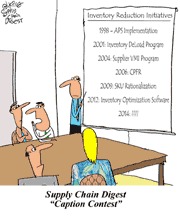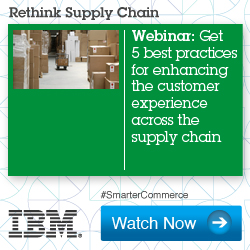 |
July 11, 2013 - Supply Chain Newsletter |
 |
| FEATURED SPONSOR: IBM |
 |
Rethink Supply Chain: Webinar |
 |
|
||||||||||||||||||||||||||||||||||||||||||||||||||||||||||||||||||||
1H 2013 Supply Chain ReviewAs I have noted in the past, it is amazing how quickly events that occurred just few months ago fade from memory, even if you do this for a living, as I do. So, I think it's good for me and our audience to review what transpired in the supply chain both at the halfway point and of course in our annual year-end review. This week: the top stories. Next week: the first half in numbers, together giving us all a chance to refresh our memory banks.
In a general sense, it really is the new normal. Economic growth continues to be positive but weak in the US. Europe stumbles along, with the debt crisis perhaps raising its head again, but at least now the comparisons are to very weak data in prior years, easing the impact. There has lately also been some weakness in many emerging markets, including China, India and Brazil. But in general, corporate profits remain high, and the supply chain is the key driver, enabling many companies to keep raising profits well above revenue growth. We should get more credit. Some data on that next week. To me, the top story of the year thus far was no question the on-going saga of the initial disaster of a building collapse in April that killed more than 1100 Bangladeshi apparel workers at the five factories operating in the structure and resulting reactions from retailers. Workers there had been initially evacuated by inspectors, who had found cracks in the structure, but employees were then ordered back in the factory hours later by managers behind on filling orders from US and European brand and retail companies. The workers went back in, leading to tragedy. This and related fatal fires in Pakistan and Bangladesh factories in 2012 led to a number of supply chain revelations, issues, and interesting moves. • The apparel supply chain here in 2013 is still largely uncontrolled and unmapped, with many if not most of these retailers and brands unaware where their garments were being produced in a complex network of sub-contracting. • After the Bangladesh collapse, Canada's Loblaw's chain and Europe's Primark, which were both sourcing garments from the building, said they would financially compensate the victims, and called on others to do the same, for a disaster at a factory neither company owned. • In May, a group of mostly European retailers (plus a couple from the US) announced a major and legally binding program that would commit those in the accord to fund as necessary repairs at their suppliers factories in Bangladesh. That move is quite a precedent, and the legal risks caused most US companies to bow out - under criticism. • First reported in late June, 17 US retailers/brands, led by Walmart and Gap stores, have launched their own plan, formally announced this week, which includes tens of millions of dollars for inspections and training, but will provide loans only for needed factory repairs, not direct funding. To me, this is a major inflection point. Just how much responsibility do sourcing companies have for fixing suppliers' facilities? Will this effort be repeated in Vietnam and elsewhere? Lots more here. Other top supply chain stories, by month: January In a story first broken by SCDigest, JC Penney tells suppliers it is backing off program to RFID tag at the item level virtually every SKU it sells, breaking a promise made in 2012 by CEO Ron Johnson. Penney will stick with tagging a few categories for now, likely to conserve cash at the struggling retailer. Johnson is shown the exit door not long after. Serious but at times humorous supply chain scandal breaks out involving horsemeat being sold as regular beef in many retail chains and even some frozen packaged food in the UK and elsewhere in Europe. Leads to some grocery stores promising costly DNA testing on all meat products. Not just food safety, but is "food integrity" coming soon? In wake of fire in Pakistan that killed 112 at a factory that was making clothes for Walmart through a sub-contract deal, Walmart announces major changes to sourcing policies, including no sub-contracting without permission, and the end of a "three strikes before you are out" approach to supplier violations. February Agreement is finally reached between the International Longshoremen's Association (ILA), which covers dock workers at 15 East and Gulf Coast ports, and the port alliance, after months of wrangling and numerous threats of a potentially crippling strike. That was some 5 months after contract initially expired. Key issue was a royalty program, dating back to the 1960s, that paid ILA workers for each container moved through the ports. Appears the union mostly won. UPS puts 100 all-electric delivery trucks into service in various parts of California. They only have a range of 75 miles on a single battery charge, however, meaning they can only work on fairly dense delivery routes. The electric trucks will cost about $178,000 apiece, or close to three times the price of conventional trucks. March Federal Appeals Court hears testimony in American Trucking Associations legal challenge against new Hours of Service rules, arguing the data used the Federal Motor Carriers Safety Association in its cost-benefit analysis was hugely flawed. Court does not rule by July 1 enforcement data, and FMCSA refused ATA request to delay rules until a decision, so rules went into effect two weeks ago. Bloomberg reports Walmart having a tough time keeping its store shelves stocked, and that the company recently put a senior executive in charge of fixing the issues. "We run out quickly and the new stuff doesn't come in," Walmart's US CEO said at a meeting. Walmart says the comments were taken out of context. Engine maker Cummins and tractor producer Peterbilt provide update on new "SuperTruck" development, funded in part by U.S. Energy Department program. Early tests show diesel mileage of 9.9 mpg, increasing current mileage performance by more than 50%. The gains come from changes to the engine and truck aerodynamics. More tests schedule for the rest of the year, but press announcement is very confident. April FBI raids homes and offices of managers and executives at giant truck stop owner Pilot Flying J, over allegations the company has for years been short changing carriers and private fleet owners on contractually promised rebates for diesel. Many class actions suits have since been filed. FedEx announces new parcel services, focused on e-commerce. For $10.00, FedEx says it will promise e-commerce deliveries within a two-hour window. For $5.00, you can reschedule the delivery day or location, with detailed instructions for the driver. And for free, customers can sign up on the FedEx website to be notified of pending deliveries by email, text or phone. May Reports from several sources say large companies such as Procter & Gamble are extending payment terms to suppliers from 45 or even 60 says to 90 or even 120 days, in a bold move to improve cash flow. Most offer bank-based factoring programs to ease their own suppliers' cash flow challenges, but real pain will be felt if interest rates rise. Reports surface that Amazon will begin testing a new on-line grocery service in the Los Angeles and San Francisco markets in weeks, and could expand that to as many as 20 markets in 2014 if successful. June Annual State of Logistics report from Rosalyn Wilson and CSCMP finds logistics costs as percent of US GDP unchanged at 8.5% in 2012. Opinion is that logistics costs unlikely to rise much in relative terms in the next few years either. Recent high point was 9.9% in 2007. American Trucking Associations largely wins important Supreme Court verdict limiting the Port of LA's ability to regulate drayage drivers, which in the end wasn't about the environment as claimed but a move to promote unionization of drayage drivers. Walmart admits it is behind in e-fulfillment vs Amazon, vows to catch-up, with major commitment to using its store network as part of the solution. The three largest container shipping carriers by capacity (Denmark's Maersk Line, Switzerland's Mediterranean Shipping Co. and France's CMA CGM) announce plans for a new alliance (called P3) in which they will pool vessels and capacity. The three account for about 37% of total global container capacity, and the move has many shippers worried. Ok, that's it. I had almost forgotten about the horsemeat scandal. Supposedly Romanians massively selling off horses to slaughterhouses after they were banned from the streets was part of the catalyst. If there are any other important events or news items we missed please let me know. First half numbers and charts next week. Any reaction to this our summary of the first half of 2013 in supply chain? Anything we missed? Let us know your thoughts at the Feedback button below.
|
|||||||||||||||||||||||||||||||||||||||||||||||||||||||||||||||||||||
|
|||||||||||||||||||||||||||||||||||||||||||||||||||||||||||||||||||||
|
|
|
YOUR FEEDBACK
Will publish a few good emails we've received lately, including a great when from David Schneider, who was at the State of Logistics press conference in Washington DC in June, and adds some nice comments from the panel discussion that augment our coverage of the written report.
And that makes it our Feedback of the Week! Plus interesting letters on the whole apparel supply chain troubles discussed above.
Feedback of the Week - On the State of Logistics Press Conference
I was present at the press conference, front row, and took notes of the Q&A session after. The opening question focused on the significant challenges each of the panel saw in 2012, and was the outlook optimistic or pessimistic: Marc Althen (president of Penske Logistics) said Penske saw an upturn as more shippers looked for 3PL services to help adjust for greater complexity in the networks: he is optimistic. Brent Beabout (Senior Vice President, Supply Chain for Office Depot ) said that the B to B business is not recovering quickly, and they continue to see pressure to improve operations by serving omni-channel demand through the same network. Cautious optimism. Steven Bobb (exec VP at BNSF) said BNSF structural changes in demand volume shifted from coal and grain to intermodal, oil and oil related industrial movements. Cautious optimism. Beth Ford (chief supply chain officer at Land O'Lakes) reported that her company saw robust growth in food commodity movements, more on a global scale. She is optimistic. Paul Svindlands (COO of Pacer) said that Pacer is cautious about its optimism, that while there will be growth, it will not be exciting growth. Paul is new at Pacer - and did not really comment about 2012. The most interesting questions and answers: HOS Impacts: Paul - Dray carriers will not be impacted anywhere like regional and long haul carriers. What kills the dray carriers productivity is the time at the ocean terminals. Rail ramps are efficient and drivers do not see the 2 - 3 hours delays that drivers see in LA or Newark. Marc - Penske expects a 3% hit to productivity. Driver Shortage: The panel all comments. Roz pointed out that the opportunity to pick up the young drivers is when they get out of High School, but they can’t get a CDL until they are 21. By that time the kids are already down a different path and not likely to change careers. Beth - the Daughter of a Truck Driver - said that the changes in the industry, and the options, makes driving less attractive. Biggest concern for 2013: Marc - Human Capital. Beth chimed in on this later, and it worked in with more driver shortage comments. Beth spoke about "The War for Talent" where she goes to colleges and finds it difficult to get the business school students excited about supply chain and logistics. She talked about a need to "change the dynamic of how people look at the career, and the impact logistics has on many parts of the organization." She went on to talk about finding people that could communicate and collaborate, not only internally, but to help "educate the front of the house to understand what the back of the house does." On the Human Capital issue, Steve had one of the best quotes: "For our front line supervision, as a railroad we are an outdoor sport. So we turn to the military to look for the front line leaders we need to put in the field." On the question about conversion from road to rail, the specific question asked about the length of haul where it makes sense to convert. Steve commented that it is more of a structural issue, that BNSF network is a long haul railroad, so by design the distances are longer than in the East. "We have ample opportunities with the structure we have, so we will focus to increase our take of what our current network supports." David K. Schneider
|
||
| Feedback on the Whole Apparel Supply Chain Saga | ||
You raise a very interesting question regarding inflections points. I think the major change is the depth of involvement that Wal Mart appears to be taking. I just wonder how much cost can be absorbed before it finds its way into the consumer's cost. I also think that many consumers might be ok with paying more to avoid future tragedies even in countries far removed from the U.S. |
||
| Feedback on What Took the Apparel Industry So Long to Address Issues? | ||
Your answer is obvious; there is no ROI in responsible sourcing. All of the incentives promote willful ignorance in the service of increasing profits and market share. I was at a food conference recently where one of the keynote themes was "Food safety should not be a competitive advantage," highlighting companies (like Earthbound and others) that share their research and innovations with the industry. One speaker got up later and said, "That's true, unfortunately blindness and irresponsibility are an advantage, allowing companies to offer lower prices and gain market share." This is equally true in apparel, consumer electronics and other industries where price is everything. Until you see CEO's comp plans with significant bonus for "0 worker injuries at supply chain partner sites" and similar measures, nothing will get fixed. Bill Alrich |
||
As one of those "human and workers' rights types," I'd like to welcome you to the party.
I have been working on the Nike sweatshop issue in Indonesia for 15 years now and I can tell you that nothing of significance has changed, regardless of what Nike tells you in their CSR report. I hope you will keep pushing on this issue.
|
SUPPLY CHAIN TRIVIA ANSWER
Q: In the famous Gartner research notes in the late 1990s (written by Art Mesher, currently CEO of Descartes) what were the "3 V's of supply chain?"
A: Visibility, Velocity, and Variability.
| © SupplyChainDigest™ 2003-2013. All Rights Reserved. SupplyChainDigest PO Box 714 Springboro, Ohio 45066 |
POWERED BY: XDIMENSION
|











